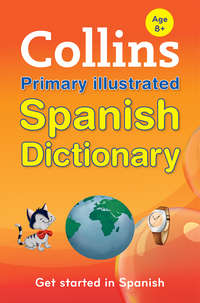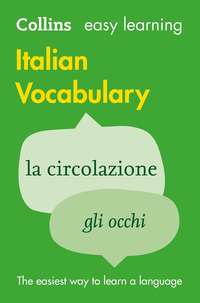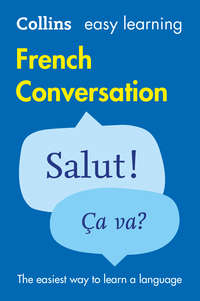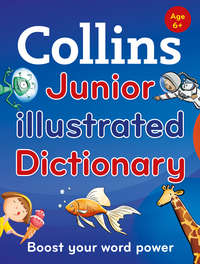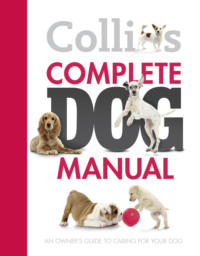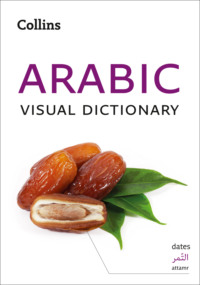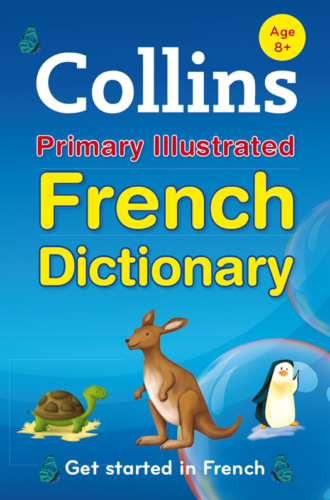
Полная версия
Collins Primary Illustrated French Dictionary

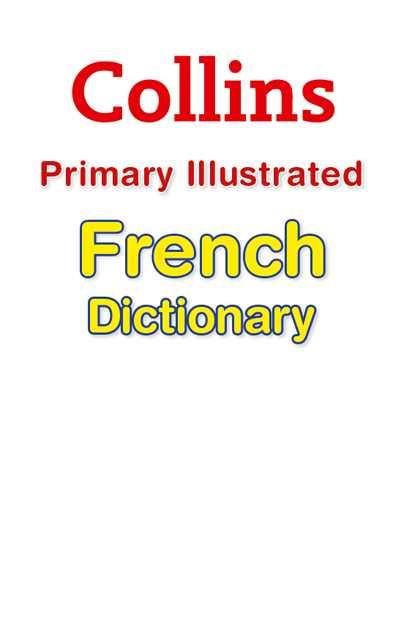
Contents
Cover
Title Page
Introduction
Using the dictionary
French – English
Language plus
Animals
The body
Clothes
Colours
Family
Days and dates
The weather
Places
Food
Fruit and vegetables
Drinks
Furniture
Instruments
Jobs
Sports
At school
Numbers and time
French verbs
Illustrations
English – French
Copyright
About the Publisher
William Collins’ dream of knowledge for all began with the publication of his first book in 1819. A self-educated mill worker, he not only enriched millions of lives, but also founded a flourishing publishing house. Today, staying true to this spirit, Collins books are packed with inspiration, innovation, and practical expertise. They place you at the centre of a world of possibility and give you exactly what you need to explore it.
Language is the key to this exploration, and at the heart of Collins Dictionaries is language as it is really used. New words, phrases, and meanings spring up every day, and all of them are captured and analysed by the Collins Word Web. Constantly updated, and with over 2.5 billion entries, this living language resource is unique to our dictionaries.
Words are tools for life. And a Collins Dictionary makes them work for you.
Collins. Do more.
Introduction
The Collins Primary Illustrated French Dictionary is a bilingual dictionary aimed at primary school children who are starting to learn French.
Access to a dictionary which is pitched at an appropriate level is a vital part of the language-learning process. The content of this dictionary has been carefully selected to reflect current trends in primary education and help children with acquiring basic language-learning skills.
The key aims of the Collins Primary Illustrated French Dictionary are:
• to develop both language skills in French and language learning skills in general
• to cover the four key areas of language attainment: listening, speaking, reading and writing
• to reinforce key aspects of the language by the use of notes and feature boxes throughout the entries
• to extend cultural awareness by providing information about France, especially where traditions differ from those in Britain
The Collins Primary Illustrated French Dictionary supports language learning in a number of specific ways:
• it develops children’s knowledge of how language works by encouraging them to understand, analyse and use simple aspects of grammar
• it develops children’s individual learning skills by using a wide range of notes that explain things in a simple but interesting way
• it enables children to make comparisons between French and English by encouraging them to explore the similarities and differences between the two languages and cultures
• it introduces young learners to all the basic elements of a bilingual dictionary and provides detailed instructions on how to get the most out of using the dictionary
The Collins Primary Illustrated French Dictionary is presented in an easy-to-use format which is intended to appeal to children of primary school age. It provides lots of simple, relevant examples and tips on how to remember words, and how to avoid some of the pitfalls of translation. It also features key phrases, illustrations and information about life in France, making it an invaluable and exciting resource.
Using the dictionary
Step one:
Pick the right side
Remember there are two halves to the dictionary. If you want to know what a French word means, look in the French-English half. It comes first.
If you want to translate an English word into French, look in the second half, which is English-French. It comes after the supplement in the middle of the dictionary.
1 Which of these words would you look up in the French-English half? demain brother horse bonbon
2 Look at page 51 of the dictionary. Is this the French side or the English side? How can you tell?
3 Look at page 411 of the dictionary. What is shown at the top of the page, above the row of dots?
4 Is fish the first or the last word on page 411?
Remember that you do not read across the whole page in a dictionary – you have to read down the columns.
5 Which word comes immediately after fireworks on page 411?
Step two:
Find the right word
A B C D E F G H I J K L M N O P Q R S T U V W X Y Z
Words are in alphabetical order in the dictionary – like names in the phone book, and in a school register. The alphabet is shown down the edge of each page of the dictionary. You can sort words into alphabetical order by looking at the first letter of each word.
6 Can you put these names in alphabetical order? Chantal, Luc, Sophie, Pierre, Jean-Marie, Hélène When two words start with the same letter, look at their second letters.
7 In alphabetical order which comes first – Hermione or Harry? This is the order of the days of the week on a calendar: Monday, Tuesday, Wednesday, Thursday, Friday, Saturday, Sunday
8 Which day comes first in a dictionary? Which comes last?
9 Thursday comes before Tuesday in a dictionary. Why?
10 Put the seven days of the week into alphabetical order. If the first letters are the same, and the second letters are the same, look at the third letters.
11 June, July, August: which comes last in the dictionary?
Step three:
Pick the right translation
The translations are easy to spot in this dictionary because they are in red on the French-English side and blue on the English-French side.
Some French words can be masculine or feminine, or even plural. In the dictionary MASC, FEM, and PL are the abbreviations used for these. The dictionary also shows you the French word for ‘the’ (this can be le, la, l’ or les).
doll NOUN
la poupée fem
When you look up doll you can see that the word for doll in French is poupée.
You can tell that the French word for doll is feminine because it is given with la and the dictionary says that it is fem (feminine).
So the doll is la poupée and a doll would be une poupée.
penfriend NOUN
le correspondant masc
la correspondante fem
I’m Emma, your English penfriend. Je suis Emma, ta correspondante anglaise.
Here there are two translations, one masculine, one feminine. If your penfriend is a boy, you need the French word which is masculine (masc) – le correspondant. If your penfriend is a girl, you need the French word which is feminine (fem) – la correspondante.
12 If you were talking about your penfriend, which would go in the gap, correspondant or correspondante?
J’ai un __________. Il s’appelle Hugo.
animal NOUN
l’ animal masc (pl les animaux)
Here there are two translations. The second one is plural (PL).
13 If you want to say that you love animals, which translation would go in the gap?
J’adore les __________.
Sometimes there is more than one translation, and each one has a number. If there is more than one translation, don’t just pick the first one! Check to see which is the right one.
ball NOUN
1 la balle fem (for tennis, golf, cricket) Hit the ball! Frappe la balle!
2 le ballon masc (for football, rugby) Pass the ball! Passe le ballon!
14 Which is the French word for a ball that you kick – une balle or un ballon? Look for the clue.
Step four:
Parts of speech
Sometimes, to pick the right translation, you need to know the part of speech of a word, for example whether a word is a noun, an adjective, an adverb or a verb. Other parts of speech are conjunction, exclamation, number, preposition and pronoun.
NOUNS
Nouns are naming words for things or people. You often use the words ‘a’ or ‘the’ with a noun – eg a girl, a boy, the school, the windows.
Nouns can be singular, eg an accident, the canteen, my dad, football – or plural, eg sweets, the children, my friends.
15 How many nouns are there in the sentence below? What are they? The car has got a flat tyre and a big dent in the door.
ADJECTIVES
An adjective is a describing word which tells you what things are like: flat shoes are shoes that don’t have high heels. A flat tyre is a tyre with no air in it.
16 How many adjectives are there in the sentence below? What are they? She’s got brown hair and blue eyes.
Some words have a noun meaning and an adjective meaning. In the dictionary there is a box to tell you about this. The different meanings usually have different translations in French.
sweet
sweet can be a noun or an adjective.
A NOUN
1 le bonbon masc (candy) a bag of sweets un paquet de bonbons
2 le dessert masc (pudding) Sweets: ice cream or chocolate mousse Desserts: glace ou mousse au chocolat
B ADJECTIVE
1 sucré masc sucrée fem (sugary) It’s too sweet. C’est trop sucré.
2 gentil masc gentille fem (kind) She’s a sweet person. Elle est gentille.
3 mignon masc mignonne fem (cute) Isn’t she sweet? Comme elle est mignonne!
17 You want to ask someone if they would like a sweet. Fill in the gap. How can you be sure this is the right translation?
Tu veux un __________?
ADVERBS
An adverb is a word which describes a verb or an adjective:
She writes neatly. The film was very good.
18 How many adverbs are there in the sentence below? What are they? What do they have in common? The children sat quietly and played happily.
Some words have an adjective meaning and an adverb meaning. The different meanings have different translations in French.
hard
hard can be an adjective or an adverb.
A ADJECTIVE
1 difficile (difficult) This question’s too hard for me. Cette question est trop difficile pour moi.
2 dur masc dure fem (not soft) This cheese is very hard. Ce fromage est très dur.
B ADVERB dur Colette works hard. Colette travaille dur.
19 You want to say you work hard. Fill in the gap in the sentence below:
Je travaille __________.
VERBS
Verbs are sometimes called ‘doing words’. They often go with words like ‘I’ and ‘you’, and with names, eg I play football, What do you want?, Hugo likes mashed potato.
Verbs tell you about the present: eg I’m listening; the past: I scored a goal; and the future: eg I’m going to get an ice cream.
20 How many verbs are there in the sentence below? What are they? School starts at 9.00 and finishes at 3.30.
Some words have an adjective meaning and a verb meaning. The different meanings have different translations in French.
clean
clean can be an adjective or a verb.
A ADJECTIVE
propre a clean shirt une chemise propre
B VERB
nettoyer Clean the board please! Nettoie le tableau s’il te plaît!
21 If you want to ask for ‘a clean glass’, how do you know that propre is the translation, not nettoyer?
Some words have a noun meaning and a verb meaning.
rain
rain can be a noun or a verb.
A NOUN
la pluie fem in the rain sous la pluie
B VERB
pleuvoir It’s going to rain. Il va pleuvoir. It rains a lot here. Il pleut beaucoup par ici.
It’s raining. Il pleut.
22 Is la pluie a noun or a verb?
23 Why is It rains a lot here. in part B?
Learn useful phrases
In the dictionary you’ll see phrases that are especially important in orange boxes. Try to learn these when you come across them, and you’ll soon know lots of useful things to say in French.
What time is it? Quelle heure est-il? It’s lunch time. C’est l’heure du déjeuner. How many times? Combien de fois?
Find out interesting things about life in France
There are also boxes which tell you about French customs, and about differences between life in France and Britain.
Did you know…?
In France, Easter eggs are said to be brought by the Easter bells or cloches de Pâques which fly from Rome and drop them in people’s gardens.
Even more words
At school you will learn to talk about subjects such as the time and the weather, your family, your pets, and your clothes. The most important words for talking about these subjects are shown in the dictionary itself, and even more words are given in Language Plus, the supplement in the middle part of the dictionary. Have a look!
Answer key
1 demain and bonbon
2 the French side; French words on it; French-English written at the side of the page.
3 fire → fish
4 It’s the last word on page 411.
5 first
6 Chantal, Hélène, Jean-Marie, Luc, Pierre, Sophie
7 Harry – because ‘a’ comes before ‘e’
8 Friday comes first and Wednesday comes last.
9 because the second letter of Thursday is ‘h’, which comes before ‘u’, the second letter of Tuesday
10 Friday, Monday, Thursday, Tuesday, Saturday, Sunday, Wednesday
11 June
12 correspondant
13 animaux
14 un ballon – the clue is in the example: un ballon de football
15 4 – car, tyre, dent, door
16 2 – brown, blue
17 bonbon – a sweet is a noun, it means candy; the example helps too
18 2 – quietly, happily; they both end in -ly
19 dur
20 2 – starts, finishes
21 because clean has an adjective meaning in this sentence; the example helps too
22 a noun
23 because it’s a verb
A a
a VERB

Language tip
Don’t confuse a with the preposition à.
1 has
Elle a beaucoup d’amis.
She has lots of friends.
Language tip
Sometimes a is used to show that something has happened in the past.
Il a joué au football. He played football.
2 is
Il a neuf ans.
He is nine years old.
il y a there is/there are
Language tip
il y a has two translations. Look at the examples.
Il y a un bon film à la télé. There’s a good film on TV. Il y a beaucoup de monde. There are lots of people.
Language tip
il y a can also mean ago.
Elle est partie il y a dix minutes. She left ten minutes ago.
Qu’est-ce qu’il y a? What’s the matter?
à PREPOSITION
Language tip
Don’t confuse à with the verb form a. See also au (= à + le) and aux (= à + les).
1 at
Je suis à la maison.
I am at home.
Je finis à quatre heures.
I finish at 4 o’clock.
2 in
Il est à Paris.
He is in Paris.
Elle habite au Portugal.
She lives in Portugal.
Mes grands-parents habitent à la campagne.
My grandparents live in the country.
au printemps
in the spring
au mois de juin
in June
3 to
Je vais à Paris.
I’m going to Paris.
Elle va au Portugal.
She’s going to Portugal.
Cet été je vais à la campagne.
I’m going to the country this summer.
Il l’a donné à son frère. He gave it to his brother. Je n’ai rien à faire. I’ve got nothing to do. Ce livre est à Paul. This book is Paul’s.
4 by
Il est arrivé à bicyclette. He arrived by bicycle. à pied on foot Je vais à l’école à pied. I walk to school. à … d’ici … from here C’est à dix kilomètres d’ici. It’s 10 kilometres from here. … à l’heure … an hour cent kilomètres à l’heure 100 kilometres an hour À samedi! See you on Saturday! À tout à l’heure! See you later!
À bientôt! See you soon! À demain! See you tomorrow!
abandonner VERB
1 to abandon
2 to give up
Je veux abandonner la natation.
I want to give up swimming.
l’ abeille FEM NOUN
bee
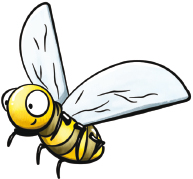
abominable ADJECTIVE
awful
l’ abord MASC NOUN
d’abord first Je vais rentrer chez moi d’abord. I’ll go home first.
l’ abricot MASC NOUN
apricot
absent MASC ADJECTIVE
(FEM absente)
absent
absolument ADVERB
absolutely
l’ accent MASC NOUN
accent
un accent aigu an acute accent un accent grave a grave accent un accent circonflexe a circumflex




